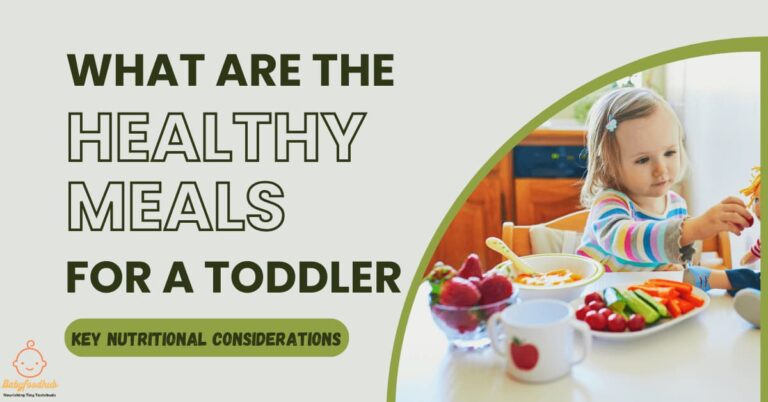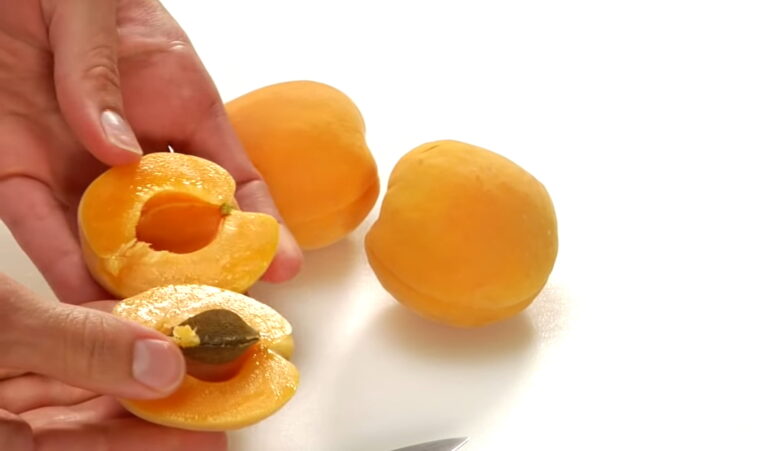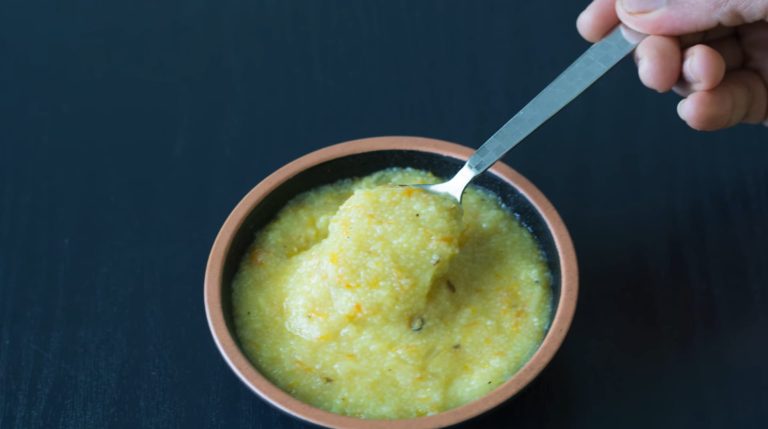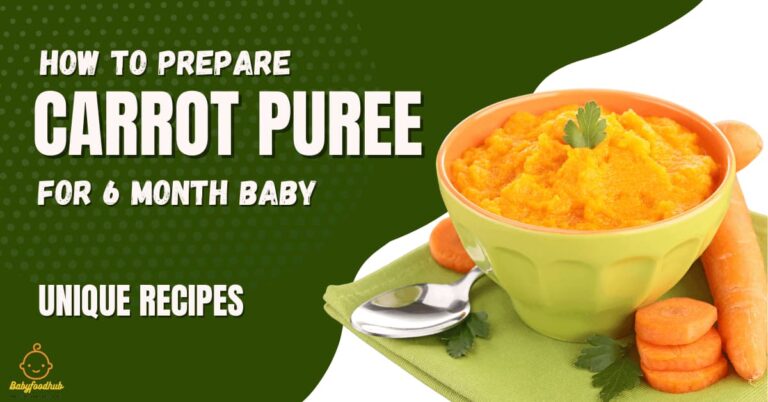How to Make Apple Puree for Baby: Quick & Nutritious Guide
To make apple puree for a baby, peel, core, and cook apples until soft, then blend to a smooth consistency. Use cooking methods like boiling or steaming to ensure the apples are tender enough to puree.
Starting your baby on solids is a milestone that comes with many questions—what to introduce and when. Introducing apple puree is a popular choice for many parents due to its smooth texture and naturally sweet taste that babies tend to love.
Apple puree is not only easy to digest for a little one’s developing digestive system but is also packed with fiber and essential vitamins like Vitamin C and various beneficial phytochemicals that promote overall health. Ensuring the puree is properly prepared and served at the right consistency can help smooth the transition to solid foods, making mealtimes enjoyable for both you and your baby.
Why Choose Apple Puree For Baby’s First Food
Choosing the right food for your baby marks an exciting and important milestone in their growth journey. Apple puree stands out as an ideal choice for this significant step. Not only is it delicious and easy for little ones to eat, but it’s also packed with essential nutrients beneficial for a growing baby. Let’s explore this nutritious option and dive into the world of homemade baby food.
Nutritional Benefits Of Apple Puree
Apples are a powerhouse of nutrition, and apple puree is a concentrated source of these benefits for your little one. Rich in vital vitamins and minerals, it helps in your baby’s overall development. Here are some key nutrients found in apple puree:
- Vitamin C: Boosts immune function and skin health.
- Dietary Fiber: Aids digestion and encourages regular bowel movements.
- Antioxidants: Protect baby’s cells from damage.
- Potassium: Essential for heart and muscle function.
Feeding your baby apple puree also introduces them to natural sweetness and a pleasant texture, making it a welcoming first food experience.
Introduction To Homemade Baby Food
Making baby food at home is a rewarding process that can ensure your baby enjoys fresh and wholesome meals. Prepared with love and care, homemade apple puree is free from preservatives and additives found in store-bought varieties. It’s a simple yet effective way to control the quality of food your baby consumes, laying the foundation for healthy eating habits. Below are reasons why homemade apple puree is a superstar in the baby food world:
| Reason | Explanation |
| Customizable Texture | Easily adjust the consistency to match your baby’s chewing and swallowing abilities. |
| Natural Flavor | Authentic taste of apples without unnecessary sweeteners or flavor enhancers. |
| Versatility | Blend puree with other fruits or vegetables to create new, exciting flavors as your baby grows. |
| Cost-Effective | Making your apple puree is often less expensive than buying pre-made options. |
Embracing the journey of creating homemade baby food with apple puree not only nurtures your baby’s palate but also infuses meals with the greatest love and care.
Picking The Perfect Apples
Making apple puree for your baby not only introduces them to a delightful taste but also offers essential nutrients beneficial for their growth. The foundation of a velvety-smooth puree starts with choosing the right apples.
Best Variety Of Apples For Baby Puree
Different apples offer unique flavors and textures. For baby puree, you want apples that are:
- Rich in flavor: A balance of sweetness and a hint of tartness creates a puree that’s appealing to tiny taste buds.
- Soft: Apples that cook down well ensure a smooth consistency for easy digestion.
Selecting organic apples can also minimize exposure to pesticides, making them a safer choice for your baby’s first foods.
| Apple Variety | Flavor Profile | Texture After Cooking |
| Golden Delicious | Mild and sweet | Soft and mushy |
| Galas | Fruity and sweet | Soft and fine-grained |
| McIntosh | Sweet with a slight tartness | Creamy and tender |
| Braeburn | Richly flavored, slightly tart | Smooth and fluffy |
Preparation Tips For Apples
Preparing apples for puree involves a few key steps:
- Washing: Rinse the apples under cool tap water to remove any surface dirt or residue.
- Peeling: Use a vegetable peeler to remove the skin, which can be tough for babies to digest.
- Corer: Remove the core and seeds with a corer or a knife as they are a choking hazard and contain harmful substances.
- Chopping: Cut the apples into evenly sized chunks to ensure consistent cooking and smoothness.
- Steaming: Steam the apple pieces until they are soft and tender, perfect for pureeing without any lumps.
Remember, for babies under six months, cooked puree is recommended to ensure digestibility and minimize allergenic risk.
Washing And Peeling The Apples
Begin by thoroughly washing and gently scrubbing the apples to remove any impurities. Next, peel off the skin with a peeler to ensure a smooth texture for your baby’s apple puree.
The first and foremost step in creating a delicious and nutritious apple puree for your baby begins with properly washing and peeling the apples. Babies have delicate digestive systems, and ensuring that the apples are free from any pesticides and contaminants is essential. Here’s a straightforward guide to get started:
- Select fresh, organic apples to minimize exposure to harmful chemicals.
- Rinse the apples under running tap water to wash away dirt and residues.
- Use a vegetable brush to gently scrub the apple’s skin.
- Pull out any stems and remove the core with a core or knife, avoiding seeds.
- Peel the apples using a sharp vegetable peeler or paring knife, taking care not to remove too much of the nutritious flesh.
Once you have bright, clean apples, you’re ready to move on to cooking them down into a perfect puree that your baby will love.
Simple Cooking Methods For Apple Puree
Cooking the apples until they’re soft is crucial for a fine puree. Choose one of these easy cooking methods:
- Steaming: Cut the apples into equal-sized chunks and steam them using a steamer basket over boiling water for about 10-15 minutes or until tender.
- Boiling: Place apple pieces in a saucepan, cover with water, and boil until they are soft, which usually takes about 15 minutes.
- Microwaving: For a quicker option, microwave apple slices in a microwave-safe bowl with a bit of water, covered, for a few minutes until soft.
Blending And Storing The Puree
After cooking, it’s time to turn those tender apple pieces into smooth puree. Transfer the cooked apples into a blender or food processor. You may add a little bit of the cooking water to achieve the desired consistency – just be sure it’s not too runny or too thick.
Blend until you get a smooth and creamy texture. If you notice any chunks, continue blending until every piece is fully pureed for your baby’s safety and comfort.
Here’s how to store the apple puree properly:
- Refrigeration: Store the puree in airtight containers or ice cube trays for on-demand portioning. It can stay fresh for up to three days.
- Freezing: For longer storage, fill freezer-safe bags or containers, leaving some space for expansion. Label with the date, and use within three months for best quality.
Credit: www.mjandhungryman.com
When To Start Introducing Apple Puree
Introducing your baby to solid foods is a significant milestone that should be met with both excitement and knowledge. Apple puree serves as an excellent first food due to its smooth texture and sweet taste, which is generally appealing to babies. The question is: when is the right time to start allowing your little one to enjoy this nutritious treat? Let’s delve into understanding the perfect timing and readiness signs for transitioning to solid foods like apple puree.
Transitioning To Solid Foods
The transition to solid foods typically begins around 6 months of age, but it’s essential to tailor this to your baby’s individual development. Apple puree can be an ideal start due to its easy digestibility and low allergenic risk. Begin with small amounts and gradually increase the quantity as your baby becomes accustomed to eating solids.
Consider these factors before starting your baby on apple puree:
- Consult with your pediatrician to tailor the introduction of solids to your baby’s specific health condition and growth curve.
- Ensure that your baby can sit upright and hold their head up, which helps reduce the risk of choking.
- Begin with pure, smooth apple puree that does not contain any added sugar or spices to monitor how your baby tolerates the food.
Understanding Baby’s Readiness Signs
Every baby develops at their own pace, making it imperative to watch for specific signs that signal they’re ready to start with solids like apple puree:
| Readiness Sign | Description |
| Interest in food | Your baby may begin to show curiosity about what you’re eating, reaching out for food and watching you as you eat. |
| Ability to swallow | Babies ready for solids will move food to the back of their mouth and swallow it rather than push it back out onto their chin. |
| Appetite increase | You might notice your baby still seems hungry after finishing their usual amount of milk. |
Remember that these signs are more reliable indicators of readiness than the exact age of your child. Once these signs appear, it might be a good time to start experimenting with apple puree, keeping a close eye on how your little one responds.
Starting with apple puree can be a wonderfully rewarding experience as you watch your baby explore new tastes and textures. By observing your baby’s cues and proceeding gradually, you’ll ensure that the introduction of new foods like apple puree is a safe and enjoyable journey for both of you.
Allergies And Precautions
Introducing solids to your baby is an exciting milestone, but it’s important to proceed with caution to ensure a safe and healthy experience. Apple puree is a popular first food for babies due to its smooth texture and gentle flavor. However, as with any new food, there are crucial considerations to keep in mind regarding potential allergies and precautions to take.
Storage And Shelf Life
Making apple puree is just step one—storing it safely is key to maintaining its freshness and nutritional value. For the best results:
- Refrigerate homemade apple puree in airtight containers; it can last for up to 48 hours.
- Freeze the puree in small batches, perhaps using an ice cube tray, for a convenient, ready-to-use portion. Use within three months for optimal quality.
- Thaw frozen puree in the refrigerator, and never refreeze previously thawed puree to prevent bacterial growth.
Safe Feeding Practices
A few measures ensure your baby enjoys apple puree without any risks:
- Introduce apple puree slowly, starting with a small spoonful to monitor for potential allergic reactions.
- Observe your baby for signs of discomfort, hives, or unusual fussiness, which can signal a food allergy or sensitivity.
- Maintain a feeding routine where new foods are given one at a time, separated by 3-5 days, to identify allergens with clarity.
- Consult your pediatrician before introducing any solids, especially if allergies run in the family.
By implementing these simple storage and feeding strategies, you are doing your best to create a nutritious, safe first-food experience for your baby.
Creating Flavor Combinations
Embarking on the journey of homemade baby food brings a spectrum of flavor possibilities to your little one’s palate. Creating Flavor Combinations with apple puree opens a world of nutritious delights, providing your baby with the opportunity to experience a variety of tastes and textures. Let’s explore how to enrich this staple fruit puree and navigate around those combos best left for later.
Nutritious Additions To Apple Puree
Mixing up wholesome ingredients with apple puree can be an entertaining way to tickle your baby’s taste buds while giving them a nutrient boost. Consider these additions to enhance both the flavor and nutritional content:
- Vegetables: Introduce veggies like cooked sweet potato, butternut squash, or pumpkin to give a beta-carotene advantage.
- Grains: Blend in cooked cereals such as oatmeal or rice porridge for added fiber and sustenance.
- Protein: Stir in a bit of finely pureed chicken or tofu to begin familiarizing your baby with new protein sources.
- Fats: A dash of avocado or a few drops of flaxseed oil can contribute healthy fats vital for brain development.
By starting with a single teaspoon of these additions and gradually increasing the quantity, your baby can smoothly adjust to more complex tastes and textures.
Always introduce new foods one at a time to monitor for allergic reactions or sensitivities and consult with your pediatrician for personalized advice.
Nutritious Apple Puree Variations
When it comes to introducing solids to your baby’s diet, apple puree serves as a splendid choice, renowned for both its nutrient-rich profile and delightful taste. Little ones typically favor the sweet, mellow flavor of apples, and parents appreciate the vitamins and dietary fiber apples provide. But why settle for simplicity when you can infuse this staple with a variety of wholesome ingredients to enhance its nutritional value and introduce your baby to new flavors? Exploring apple puree variations equips you with a versatile assortment of recipes to keep mealtime both exciting and nourishing.
Tasty And Healthy Meal Combinations
Creating balanced meals for your baby is effortless with apple puree as a base. By combining it with other purees or soft foods, you not only enrich the taste but also the nutritional content. Here’s a glimpse into some harmonious pairings:
- Apple & Carrot Puree: A vibrant blend of beta-carotene and antioxidants.
- Apple & Sweet Potato Mix: A creamy, filling concoction high in vitamins A and C.
- Apple, Oats & Cinnamon: Comforting and perfect for fiber and energy provision.
Purees offer a unique opportunity to combine various food groups, ensuring your baby gets a wide range of nutrients. Cross-combine fruits, vegetables, grains, and even mild spices for comprehensive, flavorful meals.
Frequently Asked Questions For How To Make Apple Puree For Baby
What Is Apple Puree For Babies?
Apple puree is a smooth, easily digestible food made by blending cooked apples, ideal for introducing solid food to babies.
How To Choose Apples For Baby Puree?
Opt for organic, sweet apples like Fuji or Gala that are free from pesticides and ideal for a baby’s palate and digestion.
Can You Store Apple Puree For Babies?
Yes, apple puree can be stored in the fridge for up to three days or frozen in ice cube trays for up to three months.
Is Apple Puree Safe For All Babies?
Apple puree is generally safe, but introduce it slowly to monitor for potential allergies and always consult with a pediatrician beforehand.
What Are The Benefits Of Apple Puree?
Apple puree offers vitamin C and dietary fiber, promoting healthy digestion and providing essential nutrients for babies’ growth.
Conclusion
Mastering the art of apple puree prep benefits both you and your little one. Babies relish its smooth, sweet taste, aiding their transition to solid foods. It’s simplicity at its finest—a healthy, homemade option parents can trust. Best of all, your kitchen creations introduce infants to natural flavors.
Start pureeing and enjoy the delightful perks of nutritious, fuss-free feeding!







